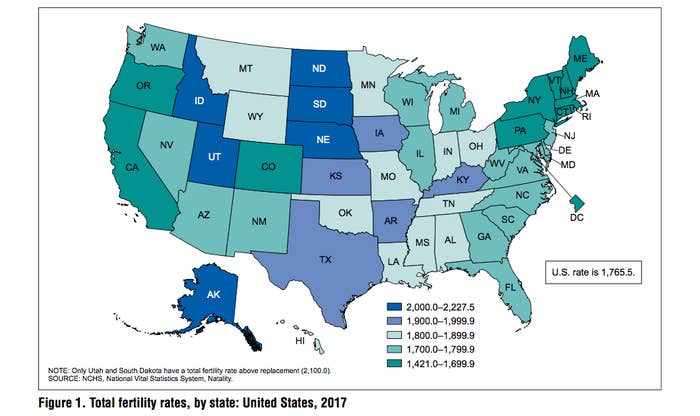
A state-by-state analysis shows the total fertility rate is much lower in some parts of the country than others.
There was a 57% difference between Washington, DC, which had the lowest total fertility rate, and South Dakota, which had the highest, according to the report from the National Center for Health Statistics.
“This is the first time we sort of focused on these particular measures at the state level, and certainly there were several noteworthy findings,” lead author Brady Hamilton, a statistician and demographer at the National Center for Health Statistics, Hyattsville, Maryland, told BuzzFeed News. “And of course one of the more striking things is the statewide differences you see in the total fertility rate.”
The total fertility rate is the estimated number of births 1,000 hypothetical women might have in their lifetime based on the age-specific birth rate in a given year. A total fertility rate of 2,100 births per 1,000 women is needed to replace a population over time, although immigration can help make up the difference.
The total fertility rate “gives you a sense of the fertility of a generation, whereas the general fertility rate is the fertility rate for a given population in a given year,” Hamilton said.
In the study, Hamilton and coauthor T.J. Mathews analyzed birth certificate data for all births in 2017, and also took a more detailed look at the three largest groups of women — non-Hispanic white, non-Hispanic black, and Hispanic women.
They found that the total fertility rate was highest in South Dakota, at 2,227 per 1,000 women, and lowest in Washington, DC, at 1,421. The rate for the US as a whole was 1,765 per 1,000 women.
The total fertility rate was above replacement level in just two states: South Dakota and Utah. No state had a total fertility rate above replacement for non-Hispanic white women, although 12 states did for non-Hispanic black women and 29 states for Hispanic women.
The general fertility rate, which is the number of births in 1,000 women ages 15 to 44, hit an all-time low, at 60.2 births in 2017, as BuzzFeed News previously reported.
That’s the continuation of a long-term trend, as fertility rates have been declining in the US for decades. For example, that number was around 69 to 70 births during the recession between 2007 and 2009.

There are a lot of factors that can go into decisions about whether to have children, and the new analysis couldn’t really determine which ones were driving the trend.
“We have information about the characteristics of the parent and where the birth occurs, but one of the things we don’t have in birth certificates are people’s decisions, their attitude, and what they are thinking — we have to rely on survey data for that,” Hamilton said.
Some people may be delaying or skipping childbearing due to economic concerns, because they are pursuing education and a career, or because that’s simply not the path they are choosing.
“It’s important to remember that these measures are based on what we see in the age-specific rates in a given time, and those change,” Hamilton said. “There are a lot of factors — the economy, people’s perceptions of what the future holds and what the future will be like, and of course the rise in pursuit of education and careers in women.”
Hans-Peter Kohler, a professor of demography at the University of Pennsylvania, said the report was “really important and insightful” but not surprising.
“We’ve known the basic trends for awhile,” he told BuzzFeed News, and they are similar to those seen in other high-income countries around the world.
It’s not clear from the data if people are delaying having children, deciding to have fewer children, or opting for no children.
And although economics can influence childbearing decisions, “I think there is a general sort of trend that there are other things in life that one can do other than having children,” he said. “It might be a greater focus on career as compared to having children, or self-realization, or some other aspects that have less to do with affordability of children.”
A total fertility rate below replacement level is probably not that big of a concern in the US, Kohler said, although other countries, like Italy and Japan, have had issues with a population skewed heavily toward older generations.
“Population aging in the US is relatively modest compared to many other high-income countries, so for sure there are a set of challenges out there, but I would argue that these challenges can be addressed,” he said. “In principle, we know the basic tools to address them, and certainly there is no need from my perspective to panic about these trends.”
